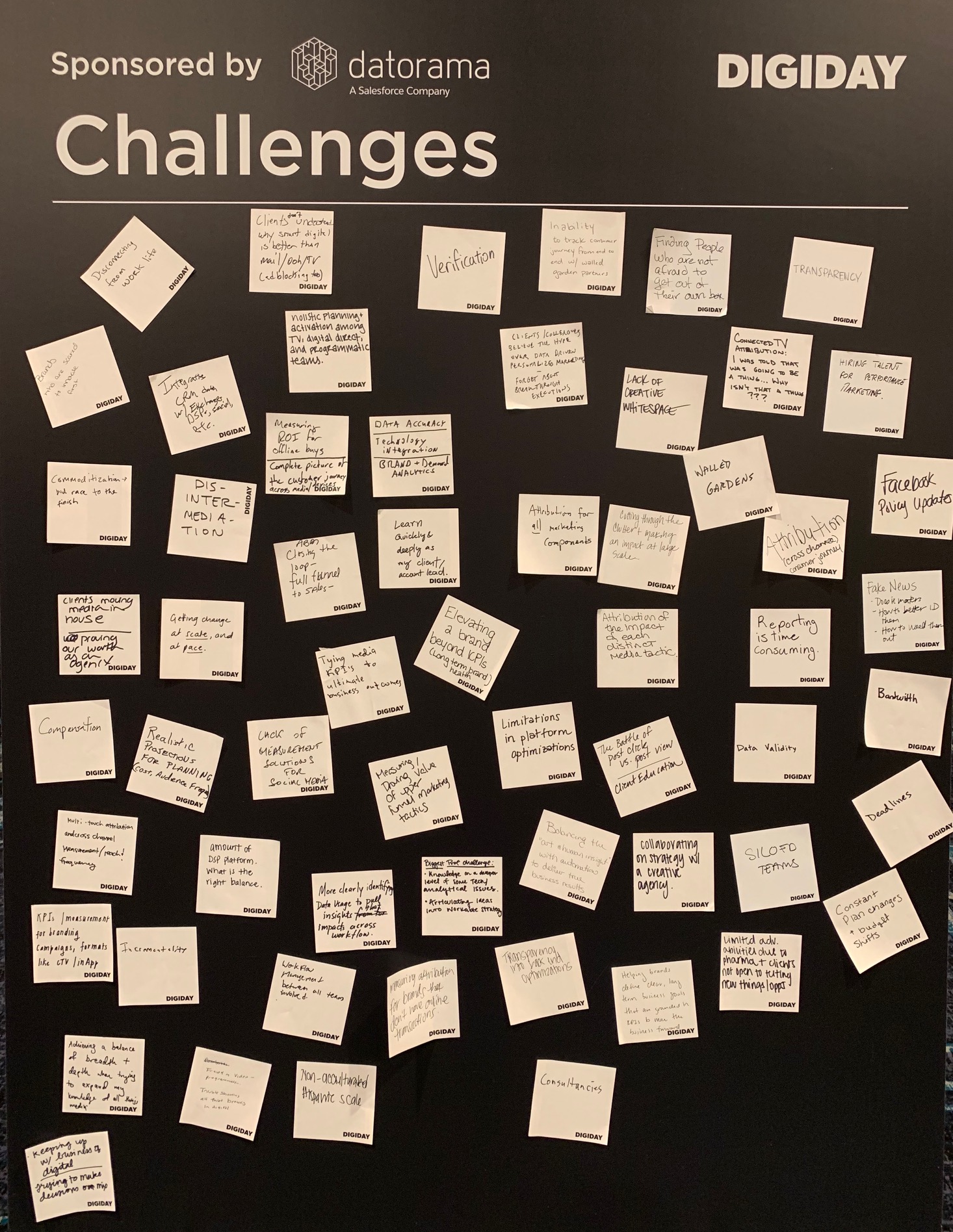
These are difficult times for agencies. They are dealing with a raft of business model challenges and new competition from consultancies — and their own clients taking more of their marketing functions in-house. On top of that, agency staffers say they’re increasingly overworked and underpaid, and many are looking for roles at clients, consultancies and technology firms instead.
Agency executives gathered in Nashville on Feb. 20 – 22 to discuss these issues and more. Here’s what attendees learned:
In-house may have a silver lining
The in-house trend is real, whether agencies like it or not. It remains to be seen if most clients can successfully and sustainably handle functions such as media planning and buying themselves, but attendees agreed that a growing number are going to try regardless. That doesn’t mean the in-house movement is all doom and gloom for agencies, however. Instead of fighting it, many attendees said they’ve seen some success in embracing the shift and adapting their approaches to capitalize on new opportunities and client needs instead.
- The obvious opportunity is for agencies to help clients with their in-house efforts. “As an agency, we’re now starting to work on a program where clients have us on retainer to bounce their in-house ideas off us,” one attendee said during a town hall session. Scaling that model might be a challenge, but it at least means agencies retain a client relationship that will inevitably continue to evolve anyway. Agencies that are confident in the value they offer clients should be comfortable with such arrangements in the short-term, one attendee said, because it’ll pay off later.
- Agencies have talked about making the shift to providing more consultancy-type services for years, instead of simply carrying out increasingly-automatable tasks such as buying media. But growing in-house interest could be forcing them to take the leap instead of just talking about it, potentially to their benefit. Changing a business model isn’t easy, but those that adapt will come out on top.
- Reality check: In-house makes sense on paper, but multiple agency attendees described situations where clients took on functions such as media planning or buying only to make a u-turn a few months later. One agency executive described the in-house movement as an opportunity to actually grow business with clients a result. One of their clients took media buying in-house, she said, only to realize how little they understood what the agency actually did. The client promptly re-enlisted the help of the agency, and threw more work its way than it had previously
The bottom line: In housing may not mean the end of agencies, but it means a different type. Agencies should be mindful of how they’re positioning themselves to clients.
It’s time to be sensible about brand safety
Brand safety was a recurring theme throughout the summit, helped along by the fact that news of YouTube’s latest crisis around its comments section broke on the first day. While attendees acknowledged that clients are increasingly concerned about the content surrounding their ads and ensuring their brands aren’t popping up in newspaper headlines, most also called for more sensible expectations. Yes, platforms could be doing more to police the quality of the content in their networks, but it’s also impossible to guarantee complete safety. And the reality is that marketers need to be comfortable with that.
- “There’s no such thing as a brand safety guarantee, it just doesn’t exist,” said GroupM’s brand safety chief, Joe Barone, echoing the sentiments of various other execs over the course of the event as he outlined WPP’s approach. “It’s not Google’s fault. We just need to be live and agile and deal with it, and accept that you can never be 100 percent sure,” said Essence North America CEO, Steve Williams (although Google itself is a key Essence client.)
- Even the platforms themselves have moved on from promising squeaky-clean environments because it’s just not technically possible. “The first thing Google said to us on the phone this week is “We’re sorry, and we’re doing everything we can to eliminate the content, but it’s still going to be there in some degree,” Barone said.
Some attendees pondered the degree to which brand safety event matters. They’ve seen little evidence that placement of a few ad impressions next to dubious content actually results in meaningful impact to the perception of a brand or a company, let alone its bottom line. “It’s just all about the screenshot,” one attendee said. Barone confirmed that he was not aware of any concrete data to suggest that bad ad placement is a significant risk beyond the potential PR headache it could cause. - Other agencies attendees said some of the drama surrounding “unsafe” content is beginning to wear off. Nobody wants their ads showing alongside unsavory content, but increasingly it’s about finding a risk profile that’s comfortable for specific clients and brands, they said. And with numerous brands now being mentioned each week in whatever the latest scandal may be, the perceived damage of some negative press might be wearing thin anyway. The real cost, therefore, is in agencies and clients spending days trying to ascertain whether or not they’ve been affected, and whether or not their safeguards worked as planned. With the latest YouTube comments scandal, Crossmedia managing director Ali Plonchak said one of the agency’s clients spent 7 cents on ad impressions on the videos in question over a six-week period, but spent days trying to figure that out. “It’s the human cost. The team didn’t get to spend that time doing optimization or strategy because it was looking for fires,” she said.
The bottom line: Agencies are thinking more pragmatically about brand safety. Discussions have moved on from the idea of zero-tolerance and are now centering more around levels of risk.
News is bad news for many advertisers
Closely linked to the notion of brand safety, attendees also debated the merits and risks of advertising alongside news. The rise of “fake news”, divisive politics and a steady drumbeat of press coverage around subjects such as data privacy and online tracking is making some advertisers avoid buying ads next to news-related content altogether, much to the chagrin of publishers.
- Some agencies said clients ask them to avoid news-related content altogether simply because of the headaches it causes. When it comes to buying programmatically there’s a lot of inventory out there, so why take the risk of an ad showing up alongside an unflattering piece of content? “’Stay the hell away’ is the go-to feel,” said one agency attendee. “The net of controversial issues has grown. The 24-hour news cycle means there’s always some kind of drama,” said another. This is more pertinent for certain types of clients than others, of course. Unlike with a few stray impressions and brand safety, one attendee said his agency believes the news environment generally can have a negative impact on a brand if they run indiscriminately.
- One advertiser’s loss could be another’s gain. Some attendees said marketers might be missing a trick by avoiding news-related inventory. With the right client or brand, and with some safeguards in place, it can perform well and is price reasonably, one agency attendee said. The challenge, though, is that technology providers simply aren’t that good at analyzing the contents or sentiment of news articles and pages yet. One potential solution for that? Publishers could be doing more on their end to tag their content for advertisers. “In many cases, they need to start working with writers to classify their stories. Most of the work is being done on our end, on the demand side. And it’s publishers who lose out,” one buyer said.
The bottom line: Depending on the client, advertising alongside news content could present an unnecessary risk or great opportunity. Either way, it shouldn’t be dismissed simply because it can be challenging to work with.
Data privacy is a headache, but an opportunity
Growing scrutiny of online ad practices and increased legislation both in Europe and the U.S. around data privacy and protection is causing a headache for everyone across the digital media ecosystem. It’s no different for agencies, but the good news is that clients are equally as confused. Rachel Glasser, chief privacy officer at Wunderman said clients are taking a growing interest in the matter. Her key points:
- Marketers are beginning to use privacy as a differentiator with some signs of success. As consumers become savvier about their data in the wake of various scandals involving platforms such as Facebook, and in the wake of legislation such as GDPR, many are thinking more carefully about which brands they interact with online. “Consumers are absolutely starting to notice changes these companies are making from privacy and transparency perspective. Even when they’re signing up for newsletters. Consumers are starting to appreciate it more. It’s not an overnight shift, it will take time. But it’s happening,” Glasser said.
- Agencies need to do more if they really want to ensure they’re being compliant when it comes to data. “There’s a black hole between what happens when a legal contract is drafted and what happens when it comes to the account team on the ground. Maybe there’s data sharing when there shouldn’t be. Maybe there’s combining of personally identifiable information with behavioral when there shouldn’t be. It’s not easy,” she said.
- Despite the headaches, data can be an opportunity for agencies to grow their relationships with clients. Agencies often talk about their role as “consultants”, and this is an area in which clients need help. “Clients are becoming a lot savvier. They’re taking an interest and educating themselves. Maybe they don’t know what they have to do but they know they have to do something. That’s great for agencies because clients want a little bit more from us,” Glasser said.
The bottom line: Data privacy is messy and difficult, but that’s precisely why agencies are well-positioned to help clients navigate it.
Overheard
“The bigger picture for all of us is this is inevitable when you digitize an ecosystem and commoditize its building blocks. Buyers are commoditized. As agencies, we need to look at the fact that buying inherently isn’t an advantage for us.” – Anonymous agency executive.
“If your career is buying and placing media and you’re starting out, you should rapidly look for some other skills to add to your resume.” – Anonymous agency executive.
“Is there even any data showing if consumers see an ad near a piece of [unsavory] content that they’re making a negative connection?” – Anonymous agency executive.
“There’s times when you see entry-level agency salaries and you wonder how people survive. The downside of that is in diversity, because you have to have mommy and daddy help you out.” – Anonymous agency executive.
“There’s no such thing as a brand safety guarantee, it just doesn’t exist.” – Joe Barone, managing partner, brand safety, GroupM.
“My team works mostly in social, and the biggest thing for us is Facebook is making it easier for people to take it in-house.” – Anonymous agency executive.
Challenge board confessions
Agency executives anonymously shared their biggest challenges. Click to zoom.
More in Media

Publishers are hunting for AI prompt data — now they’re starting to get it from third-party companies
Publishers are finally gaining some visibility into AI search, as new prompt data tools crack open a black box.

Digiday+ Research: Publishers’ growing focus on video doesn’t translate to social platforms
Major publishers have made recent investments in vertical video, but that shift is not carrying over to social media platforms.

Technology x humanity: A conversation with Dayforce’s Amy Capellanti-Wolf
Capellanti-Wolf shared insight on everything from navigating AI adoption and combating burnout to rethinking talent strategies.






